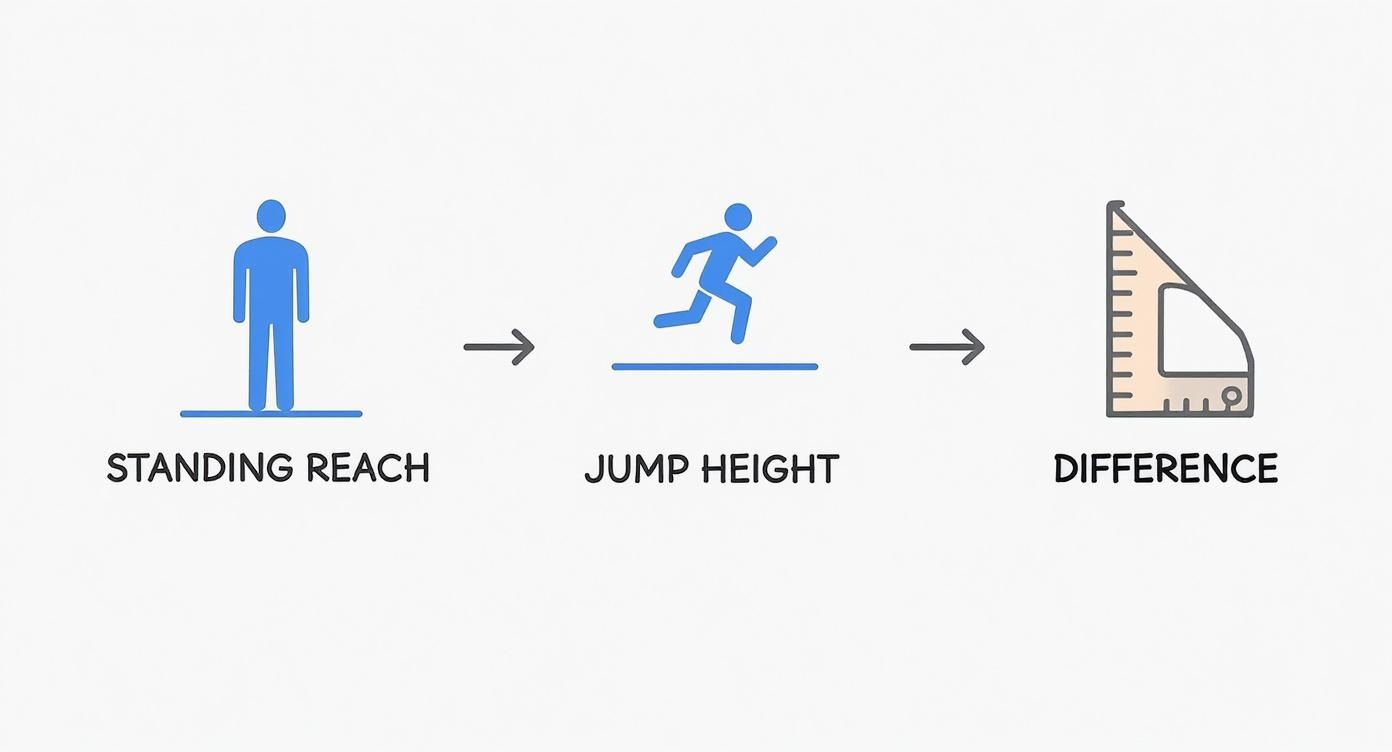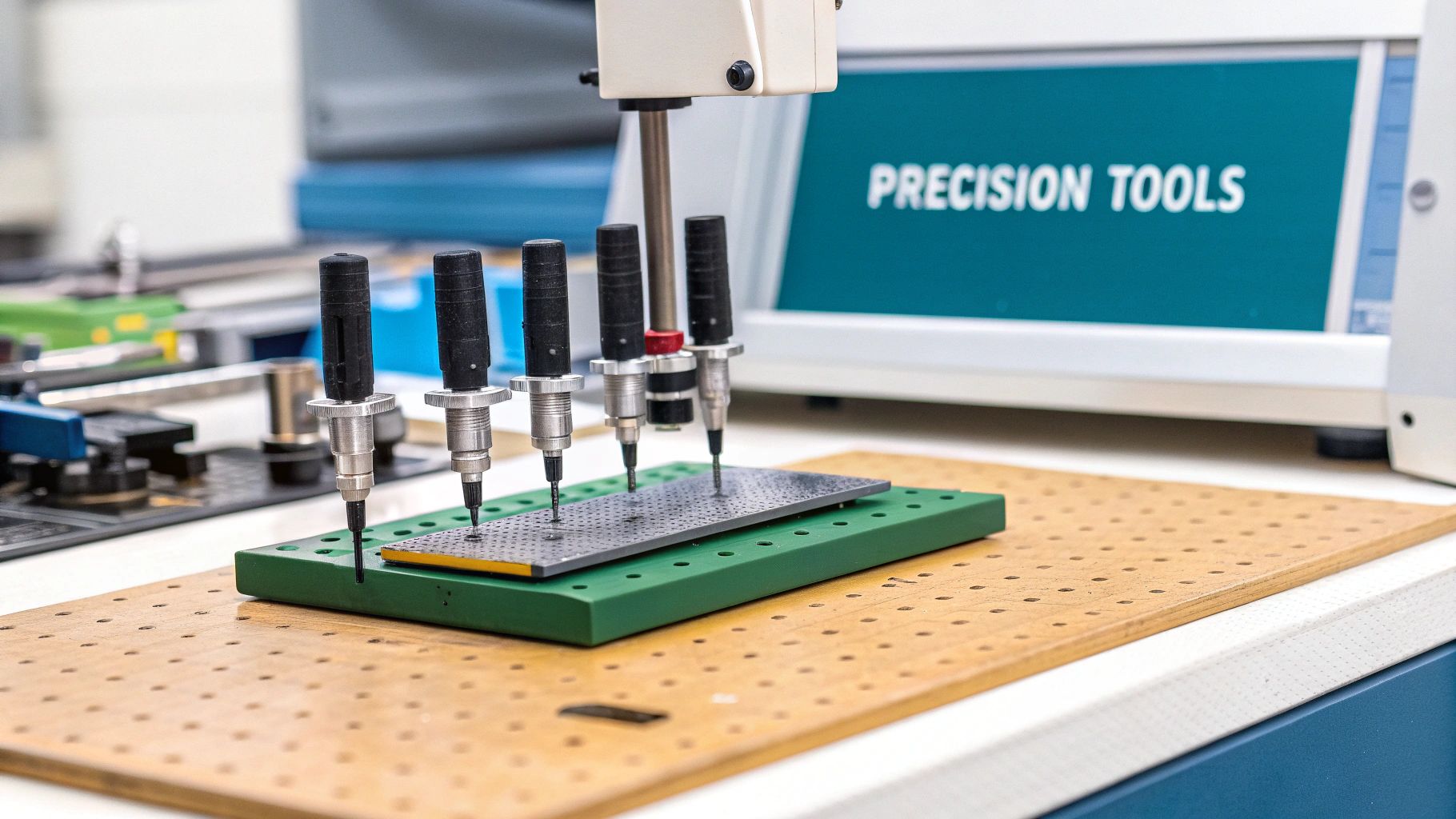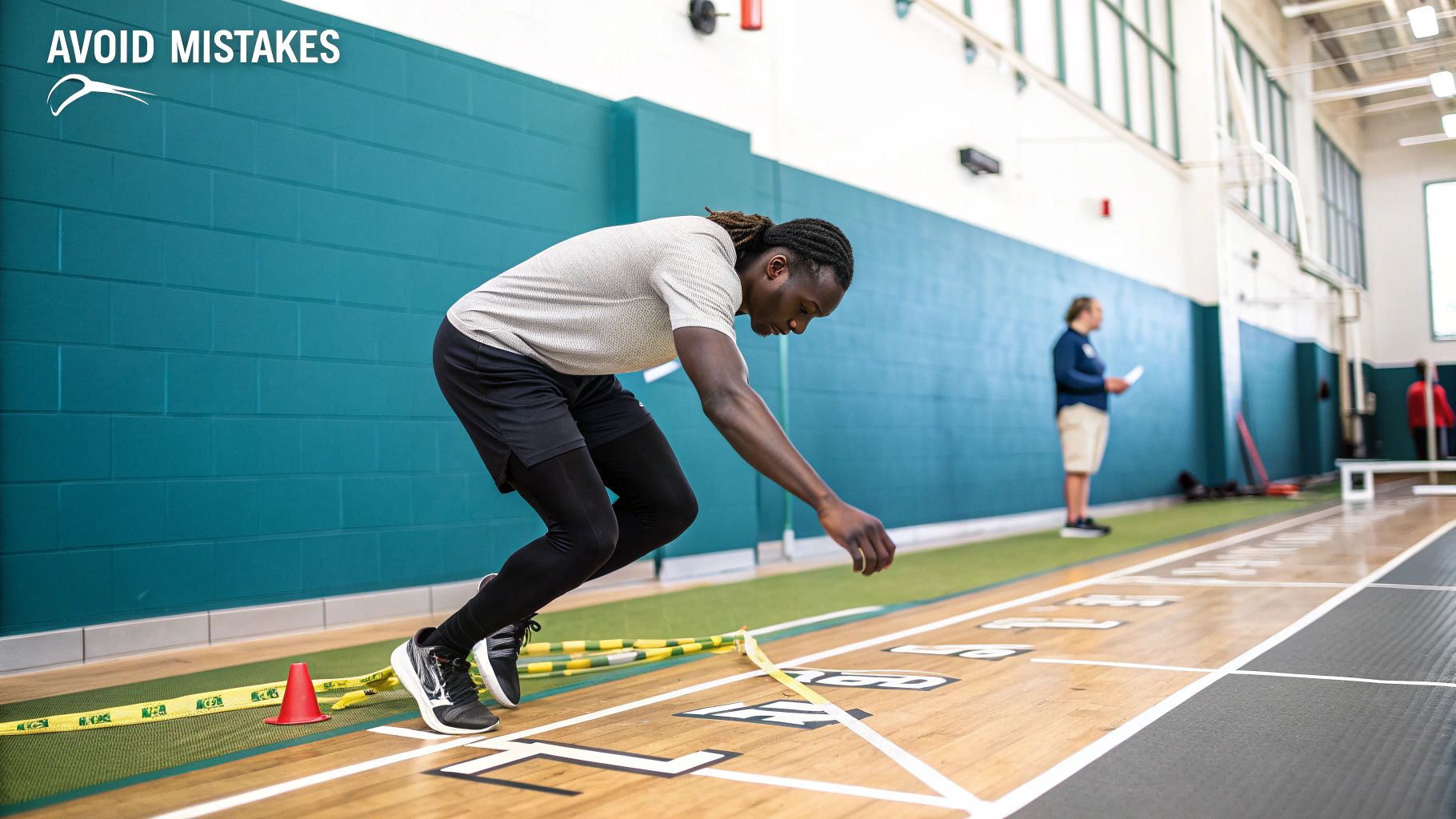-

, by Marko Dombi Athlete-Centric Care: Elevating ACL Rehab with Next-Gen Performance Tools
-

, by Marko Dombi Launch of the EasyBase - Force Plate System For Rehabilitation and Sports
-

, by Marko Dombi Interview with the researcher | Enhanced Paper Grip Test Project
How to Calculate Vertical Jump: A Scientific Guide for Athletes and Practitioners
- , by Team Meloq
- 19 min reading time

Learn how to calculate vertical jump with sport science methods. This guide covers wall tests and tech for precise results.
To accurately determine your vertical jump, you must measure the difference between your standing reach and the highest point you can touch during a jump. This simple calculation provides a powerful window into your athletic potential and the explosive power of your lower body (1).
Why Measuring Vertical Jump Is a Game Changer
The vertical jump is far more than a number for bragging rights. For physiotherapists, coaches, and athletes, it serves as a vital sign of explosive power. This single measurement offers a reliable snapshot of an individual's ability to generate force rapidly—a fundamental skill in nearly every sport. Understanding how to calculate it is the first step toward unlocking crucial performance insights.
At its core, a vertical jump is a showcase of biomechanics in action. It demonstrates how effectively an athlete can utilize ground reaction force and convert it into powerful upward propulsion. This principle is not limited to jumping; it is the same mechanism that drives sprinting and rapid changes of direction (2).
The Power of a Single Number
In sports like basketball and volleyball, the link is direct—a higher jump often correlates with better performance. But its importance extends much further. For a physiotherapist, tracking vertical jump height during rehabilitation can be a clear indicator of neuromuscular recovery, helping to determine an athlete's readiness to return to play (3). For coaches, it is a tool for talent identification, assessing the effectiveness of training programs, and monitoring fatigue.
Given the value of this metric, consistency in measurement is paramount. Inconsistent testing protocols yield unreliable data, making it impossible to accurately track progress or compare results between athletes.
A small change in technique, such as taking a preliminary step or altering arm swing, can significantly affect the measurement. This is precisely why professional testing protocols emphasize strict repeatability and standardization (4).
Foundational Measurement Principles
The basic concept behind measuring a vertical jump is refreshingly simple. As one of the most common performance tests, the most fundamental method requires only a wall and a marking tool. The process involves measuring the difference between an athlete's standing reach and the peak height they touch during a jump. First, they mark the wall at their maximum standing reach. Then, they jump and mark a new, higher point. The distance between these two marks is the vertical jump height. You can see a detailed overview of the vertical jump test and its history here.
This core principle applies to every method, from the simple wall test to advanced force plates. All aim to quantify the same thing: how effectively an athlete can propel their center of mass upward against gravity. Understanding the nuances of each method is key to obtaining trustworthy data for training and rehabilitation decisions. For a deeper dive, you can also explore our guide on understanding the Rate of Force Development to see how this connects to explosive power.
References
- Komi PV, Bosco C. Utilization of stored elastic energy in leg extensor muscles by men and women. Med Sci Sports. 1978;10(4):261-265.
- Cronin JB, Hansen KT. Strength and power predictors of sports speed. J Strength Cond Res. 2005;19(2):349-357.
- Davies G, Riemann BL, Manske R. Current concepts of anterior cruciate ligament treatment and rehabilitation. Int J Sports Phys Ther. 2015;10(6):779-808.
- Markovic G, Dizdar D, Jukic I, Cardinale M. Reliability and factorial validity of squat and countermovement jump tests. J Strength Cond Res. 2004;18(3):551-555.
Mastering the Classic Vertical Jump Wall Test
Ask any coach or practitioner about the most accessible way to measure a vertical jump, and they will likely direct you to a wall. The classic wall test is a foundational method for good reason—it’s simple, requires minimal equipment, and is widely available. All you need is a wall, a tape measure, and a marking implement like chalk.
The entire test boils down to a simple calculation: the difference between standing reach and jump reach. First, a baseline is established by measuring how high an individual can reach while standing flat-footed. Then, they perform a maximal jump, marking the wall at the peak. The distance between these two marks represents the vertical jump height.
This infographic breaks down the straightforward process visually.

As shown, the test involves three key actions: measuring standing reach, marking the jump reach, and calculating the difference.
Establishing an Accurate Standing Reach
An accurate standing reach measurement is non-negotiable. If this baseline is incorrect, the final vertical jump calculation will be invalid.
The individual should stand sideways against the wall with feet flat on the ground. They then reach straight up with the arm closer to the wall, marking the highest point their fingertips can touch. It is crucial to avoid lifting the heels or excessively elevating the shoulder girdle, as this inflates the standing reach and artificially lowers the final jump score. The feet must remain flat and the shoulders relatively square. Performing this several times helps ensure a consistent and reliable mark.
Executing the Jump with Proper Technique
Once the standing reach is established, it is time for the jump. Consistency in technique is critical for tracking progress over time. The same type of jump must be performed during every testing session. The two most common protocols are:
- Static Start (Squat Jump): The individual starts in a squat position and holds it for a brief pause (1-2 seconds). This eliminates the contribution of the stretch-shortening cycle, making it a pure test of concentric explosive strength.
- Countermovement Jump (CMJ): This is the more common method as it better mirrors natural athletic movements. The individual starts from a standing position, drops quickly into a squat, and immediately reverses the motion into a maximal jump (1).
Regardless of the chosen method, the objective is to touch the wall at the absolute peak of the jump. Applying chalk to the fingertips can facilitate clear marking.
A critical rule in sports physiotherapy and performance testing is the prohibition of preliminary steps. Any shuffling or stepping motion can add inches to a jump, effectively turning a vertical jump test into a running jump test and rendering the data useless for standardized comparison.
Common Errors to Troubleshoot
Reliable data is born from sound technique. Even minor inconsistencies can compromise results. Be vigilant for these common errors:
- Inconsistent Arm Swing: The arms contribute significantly to upward momentum. A weak or poorly timed arm swing can reduce jump height. The arm swing should be powerful and consistent across all attempts.
- Drifting Away from the Wall: If the individual jumps away from the wall, their reach becomes more horizontal than vertical, preventing them from marking their true peak height. They should stay as close to the wall as possible.
- Testing While Fatigued: Testing after a strenuous workout is counterproductive. Neuromuscular fatigue significantly impairs explosive power. Testing should always be conducted when the athlete is fresh, typically after a thorough warm-up but before any demanding training.
By standardizing the approach to the wall test and avoiding these common mistakes, you can obtain reliable data to effectively track athletic progress.
References
- Markovic G, Dizdar D, Jukic I, Cardinale M. Reliability and factorial validity of squat and countermovement jump tests. J Strength Cond Res. 2004;18(3):551-555.
Interpreting Your Jump Height: What the Numbers Mean
So, you have a measurement. What does it signify? A vertical jump height is just data until it is placed in context. Its true value emerges when you understand where that number fits, transforming a simple measurement into a powerful tool for goal setting and progress tracking.
Your vertical jump is a direct reflection of your lower-body explosive power. However, it is a multifactorial trait influenced by genetics, training history, age, sex, and the specific demands of a sport. For instance, a 50 cm (approx. 20 inches) jump may be excellent for a 14-year-old athlete but would be considered average for a collegiate basketball player.
This highlights why comparing results to relevant normative data is essential for an accurate interpretation of performance.
Benchmarks Across Different Populations
To make sense of a score, we must turn to sports science literature. Published benchmarks reveal that vertical jump performance varies significantly across different ages, training levels, and sports.
For example, studies have shown that the average vertical jump for college-aged males is typically between 40-45 cm (approx. 16-18 inches), while elite male athletes in sports like volleyball and basketball often exceed 70 cm (approx. 28 inches) (1,2). In contrast, elite female volleyball players average around 55-60 cm (approx. 22-24 inches) (3). This data immediately provides a clearer picture of where an individual stands relative to their peers or a target population, helping to determine if they are ahead of the curve or have significant room for improvement.
Contextualizing Your Performance
Beyond general population data, examining benchmarks specific to your sport is even more valuable. A volleyball middle blocker and a soccer goalkeeper both require explosive power, but the performance demands—and thus the expected jump heights—are distinct.
As a sports physiotherapist, a key principle is that "good" is relative. We don't just ask, "How high did you jump?" We ask, "How high do you need to jump for your sport and position?" This question is what truly guides effective training interventions.
To help you see where you might fit, the table below provides a general comparison of vertical jump performance across different athletic levels.
Vertical Jump Performance Benchmarks by Athletic Level
This table provides a comparison of typical vertical jump ranges for different populations, helping athletes contextualize their own performance.
| Athlete Group | Vertical Jump Range (Inches) | Vertical Jump Range (cm) |
|---|---|---|
| Untrained Adult Male | 16-20 inches | 40-50 cm |
| Collegiate Athletes (Male) | 24-28 inches | 60-70 cm |
| Elite Athletes (Male) | 28-34+ inches | 70-86+ cm |
These figures are not intended to be discouraging but should serve as guideposts. They help in setting realistic, achievable short-term goals while maintaining focus on long-term potential.
Understanding the average jump height for different groups is the ideal starting point for any athletic journey. By placing your number in the right context, you transform it from a static measurement into a dynamic roadmap for improvement.
References
- McNeal JR, Sandstead KD, Del Garbino K. A comparison between the effects of a 6-week heavy resistance training program and a 6-week plyometric training program on the vertical jumps of collegiate athletes. J Strength Cond Res. 2005;19(4):E23.
- Ziv G, Lidor R. Vertical jump in female and male basketball players—a review of the literature. J Strength Cond Res. 2009;23(9):2683-2689.
- Lidor R, Ziv G. Physical characteristics and physiological attributes of female volleyball players—a review. J Strength Cond Res. 2010;24(7):1963-1973.
Advanced Tools for Precision Jump Measurement
While the wall test provides a solid baseline, it is not the definitive method. Sports scientists, physical therapists, and professional organizations require greater precision. When every centimeter can make a difference, advanced technology delivers the objective, repeatable data that simpler methods cannot provide.
These tools are designed to minimize human error and offer deeper insights into an athlete's power and performance capabilities.

From specialized mechanical devices to sophisticated electronic systems, each tool offers a unique combination of accuracy, cost, and practicality. The appropriate choice depends on the specific setting, as a high school gym has different needs and budgets than a university performance laboratory.
Vertec and Similar Mechanical Devices
Anyone who has attended an athletic combine has likely seen a Vertec. This tall vertical pole features adjustable plastic vanes. The protocol is straightforward: an athlete jumps and displaces the highest vane they can reach. This method is an improvement over a chalk mark, as it provides a standardized, visible target.
However, it is not without limitations. Its primary drawback is that it still measures jump reach, not the true displacement of the athlete's center of mass. This means an athlete with a longer reach could achieve a better score than a more explosive athlete with shorter arms, potentially skewing data when comparing individuals with different body types.
Jump Mats and Flight Time Calculation
Contact mats, or jump mats, adopt a more scientific approach by measuring flight time—the precise duration an athlete is airborne. The system operates on a simple principle:
- The mat's internal timer begins the instant the athlete’s feet leave the surface.
- The timer stops the moment their feet make contact again.
- Using a basic kinematic equation (Jump Height = g * t² / 8, where g is acceleration due to gravity and t is flight time), the system converts flight time into a precise vertical jump height (1).
This method is highly reliable and assesses an athlete's aerial ability directly, making it a popular choice in many training facilities that require a balance of accuracy and ease of use.
The Gold Standard: Force Plates
For the highest level of accuracy and the most detailed data, force plates are unparalleled. In the field of biomechanics, these platforms are the undisputed gold standard, utilized in university research labs and elite sports organizations.
They do not just measure how high an athlete jumped; they analyze the entire force production process from the ground up.
Force plates measure the ground reaction forces produced during takeoff. From this single movement, they can calculate a host of powerful metrics:
- Peak Power Output: The maximum rate of energy production.
- Rate of Force Development (RFD): How quickly an athlete can generate force.
- Asymmetries: Critical differences in force production between the left and right limbs.
This level of detail is invaluable for identifying subtle weaknesses, optimizing training programs, and informing return-to-play decisions after an injury. For a more in-depth look at the specifics, you can explore our comprehensive guide to force plate testing.
The record-breaking performances seen at professional combines are measured with this level of technology. For example, the highest standing verticals recorded at the NFL and NBA Combines demonstrate elite power measured with pinpoint precision.
For athletes serious about gaining every possible advantage, advanced wearable football sensors can also provide granular data on explosiveness and other key metrics that directly contribute to vertical jump performance.
References
- Leard JS, Cirillo MA, Katsnelson E, et al. Validity of two alternative systems for measuring vertical jump height. J Strength Cond Res. 2007;21(4):1296-1299.
Common Measurement Mistakes to Avoid
The principle of "garbage in, garbage out" is critically relevant when calculating vertical jump. Obtaining accurate, repeatable data is as important as the jump itself. If measurements are inconsistent, it is impossible to determine if training interventions are effective.
Even minor deviations in the testing protocol can significantly skew results. The goal is to create a controlled environment, similar to that in a sports science laboratory. Let's break down the most common mistakes to ensure you collect data you can trust.

Technical Flaws in Execution
Frequently, the most significant errors stem from inconsistent technique. These small deviations directly impact the numbers and make tracking true progress impossible.
One of the most common issues is an inconsistent starting position. Performing a countermovement jump one day and a static-start jump the next means you are not comparing the same athletic quality. The countermovement utilizes the stretch-shortening cycle, which can significantly increase jump height compared to a static start (1). Choose one style and adhere to it for all testing sessions.
Another classic error is taking a small step or hop before takeoff. This subtle movement introduces horizontal momentum, which is then converted into vertical lift, artificially inflating the score. A true vertical jump must be initiated from a complete standstill.
Finally, ensure a maximal effort on every attempt. Failing to fully extend the dominant arm at the peak of the jump will result in an under-recorded height. The athlete must be focused on achieving maximum reach with their fingertips on every jump.
Overlooking Environmental and Physical Variables
The human body is not a machine, and the testing environment is rarely a perfectly controlled lab. These variables can create noise in your data if not accounted for.
Pay close attention to these factors:
- Testing Surface: Jumping on a compliant surface like a gym mat versus a rigid surface like a basketball court will yield different results. The surface affects the efficiency of force transfer. Always test on the same surface.
- Athlete Fatigue: This is a major performance inhibitor. Testing vertical jump after a strenuous lower-body workout will not reflect an athlete's true explosive capabilities. For the most accurate measurement, test when the athlete is fresh, following a standardized warm-up but before any fatiguing training.
- Inconsistent Warm-up: A proper warm-up primes the neuromuscular system for optimal performance. An inconsistent warm-up protocol will lead to inconsistent performance. Standardize the warm-up for every testing session.
A core principle in sports physiotherapy is controlling the controllables. While you cannot change an athlete's genetics, you can and must standardize the testing protocol. This commitment to consistency is what distinguishes noisy data from valuable performance insights.
By managing these technical and environmental details, you can be confident that observed changes in vertical jump scores are due to genuine athletic improvement, not measurement error.
References
- Markovic G, Dizdar D, Jukic I, Cardinale M. Reliability and factorial validity of squat and countermovement jump tests. J Strength Cond Res. 2004;18(3):551-555.
Common Questions on Vertical Jump Testing
In performance training and rehabilitation, certain questions about calculating the vertical jump arise frequently. Clear, evidence-based answers are essential for ensuring your testing protocol is both accurate and useful. Let's address some of the most common inquiries from practitioners and athletes.
What Is the Difference Between a Standing and Running Jump?
A standing vertical jump, such as the countermovement jump (CMJ), is designed to measure pure lower-body explosive power from a static start. This is the gold standard for most clinical and performance assessments because it isolates the ability to produce vertical force.
A running jump, in contrast, allows an individual to build horizontal velocity and convert that momentum into vertical lift. This nearly always results in a higher measurement and is more specific to in-game actions, like a layup in basketball. While it is a valuable skill to test, it represents a different physical quality and must not be conflated with a standing jump when tracking progress (1).
How Often Should I Test My Vertical Jump?
In this context, more is not better. Vertical jump ability does not change dramatically from one day to the next. Testing too frequently, especially under fatigued conditions, will produce noisy, misleading data and may increase injury risk.
Most conditioning specialists recommend testing every 4 to 6 weeks. This interval provides sufficient time for physiological adaptations to training to occur, allowing you to measure genuine changes rather than daily performance fluctuations.
Is It Better to Test With or Without an Arm Swing?
This depends entirely on the purpose of the test. A powerful arm swing can contribute 10% or more to jump height by generating significant upward momentum (2). For most athletic assessments, testing with an arm swing is preferred because it reflects how athletes jump in sport-specific contexts.
However, if a practitioner wishes to isolate the explosive power of the lower limbs, they may instruct the athlete to test with hands on their hips. The most important rule is consistency. Whichever method is chosen, it must be used for all subsequent tests to ensure valid comparisons.
What’s More Important: Jump Height or Jump Technique?
The two are intrinsically linked. While achieving greater height is the ultimate goal, suboptimal technique will limit an athlete's potential and can lead to inconsistent results or even injury.
Proper form—characterized by a fluid and efficient countermovement, a powerful arm swing, and a stable landing—ensures that the power generated is effectively translated into vertical displacement. In practice, refining technique is often the most direct path to unlocking a higher and safer jump.
Ready to ditch the guesswork and get precise? Meloq offers a complete suite of digital measurement tools, including the EasyForce dynamometer and the EasyBase force plate, built for movement professionals like you. Capture objective data on strength, balance, and jump performance to make smarter training and rehab decisions.
Explore the entire Meloq ecosystem at https://www.meloqdevices.com.
References
- Young W, James R, Montgomery I. Is muscle power related to running speed with changes of direction? J Sports Med Phys Fitness. 2002;42(3):282-288.
- Lees A, Vanrenterghem J, De Clercq D. The maximal and submaximal vertical jump: implications for strength and conditioning. J Strength Cond Res. 2004;18(4):787-791.



